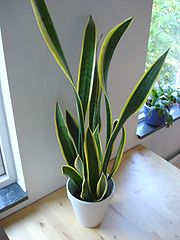Sansevieria trifasciata
From Wikipedia, the free encyclopedia
| Snake Plant | ||||||||||||||
|---|---|---|---|---|---|---|---|---|---|---|---|---|---|---|
 Sansevieria trifasciata in flower
|
||||||||||||||
| Scientific classification | ||||||||||||||
|
||||||||||||||
| Binomial name | ||||||||||||||
| Sansevieria trifasciata Prain., 1903 |
Sansevieria trifasciata is a species of Sansevieria, native to tropical west Africa from Nigeria east to the Democratic Republic of the Congo. It is an evergreen herbaceous perennial plant forming dense stands, spreading by way of its creeping rhizome, which is sometimes above ground, sometimes underground. Its stiff leaves grow vertically from a basal rosette. Mature leaves are dark green with light gray-green cross-banding and usually range between 70–90 cm in length and 5–6 cm in width.
It is commonly called the snake plant, because of the shape of its leaves, or mother-in-law's tongue because of their sharpness. In Japan it is also called 'Tiger's Tail,(とらのお)'. In Brazil it is commonly known as espada-de-são-jorge (sword-of-saint-george). Due to its bladelike shape, it is commonly associated with Ogum, the orisha of war (usually associated with Saint George), and is used in rituals to remove the evil eye. A yellow-tipped variant is known as espada-de-santa-barbara (sword-of-saint-barbara), and is associated with Iansan/Oya, the female orisha of storms (usually associated with the sword-bearing image of Saint Barbara). In Africa the plant is used as a protective charm against evil or bewitchment.
Contents |
[edit] Cultivation and uses
Like some other members of its genus, S. trifasciata yields bowstring hemp, a strong plant fiber once used to make bowstrings.
It is now used predominantly as an ornamental plant, outdoors in warmer climates, and indoors as a houseplant in cooler climates. It is popular as a houseplant as it is tolerant of low light levels and irregular watering; during winter it needs only one watering every couple of months. It will rot easily if overwatered. It is also often used as an air filtering plant because it has a tendency to absorb certain poisonous substances.[1]
Numerous cultivars have been selected, many of them for variegated foliage with yellow or silvery-white stripes on the leaf margins. Popular cultivars include 'Compacta', 'Goldiana', 'Hahnii', 'Laurentii', 'Silbersee', and 'Silver Hahnii'.
It can be propagated by cuttings or by dividing the rhizome. The first method has the disadvantage that the variegation is likely to be lost.
S. trifasciata is currently considered a weed in Australia.[2]
[edit] Gallery
[edit] References
- ^ B. C. Wolverton, Rebecca C. McDonald, and E. A. Watkins, Jr. "Foliage Plants for Removing Indoor Air Pollutants from Energy-efficient Homes" (PDF). http://ntrs.nasa.gov/archive/nasa/ssctrs.ssc.nasa.gov/foliage_air/foliage_air.pdf. Retrieved on 2007-05-03.
- ^ S. Csurhes and R. Edwards (1998). "Potential environmental weeds in Australia: Candidate species for preventative control" (PDF). Queensland Department of Natural Resources. http://www.weeds.gov.au/publications/books/pubs/potential.pdf. Retrieved on 2008-04-23.
[edit] External links
- Germplasm Resources Information Network: Sansevieria trifasciata
- "How to Grow Your Own Fresh Air" using Sansevieria trifasciata (TED talk)
| Wikimedia Commons has media related to: Sansevieria trifasciata |





